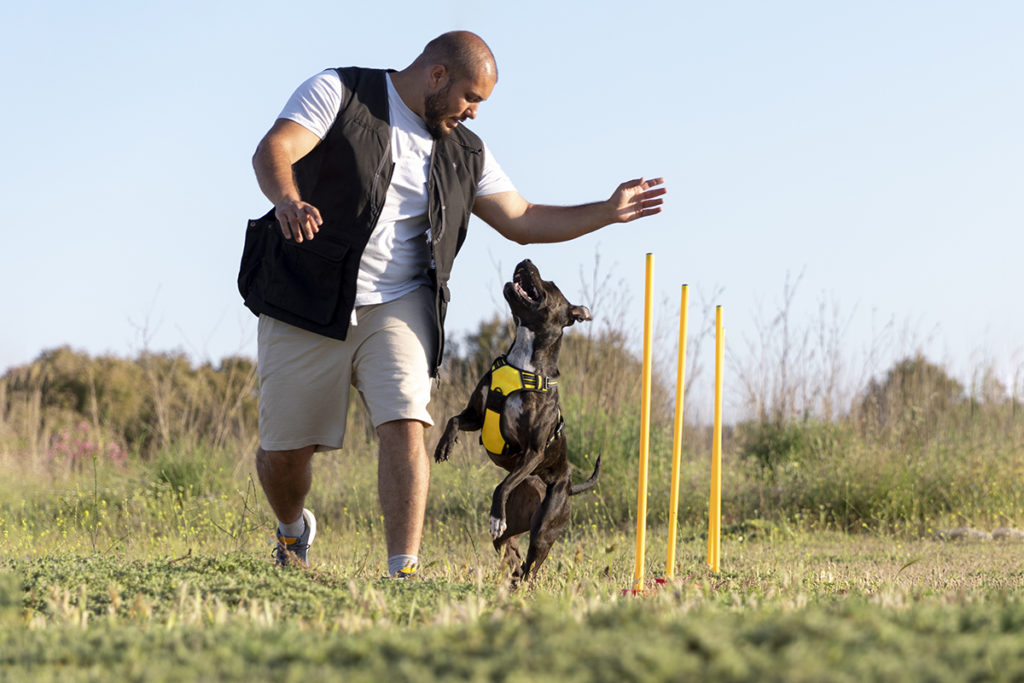Dog boarding and training can help owners who don’t have the time or knowledge to train their pets, but it can be expensive and may not always be the right fit for every business owner. In this article, we’ll discuss what you need to know to decide if offering dog board and training services will be the right choice for your dog training business.

What Are Dog Board and Train Services?
First, it is important to fully understand what board and train services entail. Board and training services for dogs are essentially when a client leaves their dog with the dog trainer for a certain period of time in order to get in-depth training. It is similar to doggy daycare or traditional dog boarding but with advanced training and extra time spent with the trainer.
These dog training sessions can last anywhere from one night to multiple weeks, depending on the level of training needed.
Board and train services commonly take place at one of two locations. Either at the dog trainer’s home or a specific board and train facility.

In-Home vs. Kennel Board and Train
If you are debating offering board and train in your dog training repertoire, you first need to decide if you will be using an in-home or kennel-based system.
For in-home boarding and training, you will keep the client’s dog at your home, essentially treating it like a member of your own family for a time. Because a dog is kept in your home, they will be learning the basics of indoor living, such as not surfing counters, house training, and respecting invisible boundaries. Home-based boarding and training is also highly beneficial for socializing dogs in an in-home environment like the one they will experience when they graduate and go home to their owners.
This type of training is very appealing to individuals who want to be able to easily transition their new dog into their home with minimal stress on their part.
Many board and training programs require a 2-week minimum stay, but some offer one week if just a basic refresher course is needed. So if you are debating adding in-home dog training to your services list, just keep in mind that this is a considerable time commitment but one that is highly beneficial for the dog.
Unlike in-home board and train, kennel board and train will keep the dogs at a specific boarding facility separate from your home. In this situation, dogs are kept in kennels, sometimes with a large number of other dogs being boarded at the same time.
This type of boarding and training is good for businesses that are doing a large volume of dogs being brought in regularly, though it is slightly less personal than the in-home option.
Many clients have reported that they prefer dog trainers who offer in-home as opposed to kennel-based training. Other clients prefer the more regimented and affordable kennel-board and train option.

Is There a Third Board and Train Option?
Many trainers don’t want to do boarding in their own homes but also want to be able to offer something more personal than kenneling. But is there such a thing? Something between in-home and kennel based? Actually, there is!
Many dog trainers are moving towards a hybrid model where they have a facility for boarding and training but lean towards a much more personalized “home-based” approach to the training.
Instead of keeping dogs in kennels like in traditional board and train, there is the option to turn your boarding facility into a cozy location set up like a home would be. With rooms and features just like they would experience within a home environment. Each dog that you accept into boarding will have their own room in this mock-home facility. That way, they can be separated from other dogs if you are not on location, but they still have a home-like experience.
While this hybrid model is an excellent model for dog boarding and training, it is a more expensive one for you as a trainer. You will need a specialized location that is set up like a home environment, which can start to get quite costly depending on the area you live in and the cost of materials. However, this option is often the best way to offer a premium-priced service that you can do at volume.
No matter which model works best for your business, dog board and train services can be very beneficial to both you as a business owner and your clients.
Should My Dog Training Business Offer Board and Train Services?

There are numerous benefits to offering dog board and train services to your clients, but there are also some cons. Dog board and train will add a significant amount to your income, making it possible to hit that 100K Dog Trainer income goal, but it will also be a considerable amount more effort to get started. This is something that you will have to weigh out personally to see if it is worthwhile for your business. We will break down these pros and cons of dog board and train services so you can make an informed decision for your business.
High-Profit Potential
Dog boarding and training is a service that offers a potentially high rate of return. Depending on the type of program and the location, you can charge upwards of $1000 for a dog board and train stay, which could lead to sizeable profits for pet professionals offering these services.
Most people are willing to pay for results, experience, and convenience. Dog board and train offer all of these things, and most dog owners will see it as a worthwhile investment. As such, it’s a great option for those looking to grow their dog training business and increase their profits.
Complex Training Techniques
Training dogs can be incredibly complex and require specialized training techniques. When offering dog board and train services, you will be expected to have a higher level of expertise than general pet care or basic obedience classes.
It is essential that you understand the various dog training methods before taking on such clients; otherwise, there is a risk of failing to deliver on expectations. As a result, it’s important to invest time in studying different methods and attending seminars in order to hone your craft.

Increasing Demand
The demand for board and train services is on the rise as people are becoming more aware of the benefits associated with this type of dog training. A dog board and train program can offer a much-needed respite for pet owners who would otherwise be unable to provide appropriate care for their dogs.
Additionally, it provides an opportunity to socialize the dog as well as improve undesirable behaviors or introduce new ones. There’s potential for huge growth in the area of board and train services if you’re willing to put in hard work and invest in your craft.
Downsides to Board & Train
While board and train services are growing in popularity, there are still some downsides to this dog training method.
The first downside to dog board and train is that the dog will likely require an adjustment period when it first comes to your home or facility. Typically, this is a few days, but with dogs that are more anxious it can take a bit longer. This means that as a trainer, you have an even longer commitment and that you won’t be training much in the first few days the dog is at your facility.
Along the same vein as the adjustment period, the dog also doesn’t have a truly trusting relationship with you as a trainer when they first come into your program. With traditional training, the owner is heavily involved and since the dog trusts their owner already, you won’t need to spend as much time building that trust factor.
The final downside is that while you can effectively train the dog, this method makes it slightly more difficult to train the owner. Dog owners will need to maintain the skills and behaviors that their furry friend has learned during their time away, but there is no guarantee that they are equipped to do so. In order to negate this, it is important that you give instructions to the owner and recommend that they book follow-up sessions with you in order to get the most out of their board and train session.

Challenges With Scheduling
One of the most common challenges associated with dog board and train services is that it can be difficult to manage, especially for those without prior experience. Scheduling conflicts may arise when you’re attempting to provide care throughout the week and have multiple clients; all the while, you must also factor in time for training and behavior modification.
While many dog trainers say that scheduling and time maintenance is one of their biggest challenges when it comes to board and train, our PocketSuite pros have let us know that they don’t experience these same issues. With our all-in-one dog training software, professional dog trainers are able to easily manage their schedule, get bookings online, check in their reservations, and send out invoices and reminders to clients automatically. So if scheduling is a challenge to you, check out PocketSuite to simplify your business and get back to what you love, training dogs!
Cost and Regulations
The final thing that you need to keep in mind if you are considering adding dog board and train services to your repertoire is the cost involved. These costs can vary wildly depending on your location and the legal requirements in your area, so be sure to do your research and know exactly what you need before getting started .
When maintaining a dog board and train facility, you will need to maintain the proper insurance and manage that property’s bills (mortgage costs, electricity, water, etc.). Depending on your state, these facilities must also be regulated by one or more government entities.
If you choose to do an in-home board and train service, you can cut down on some of the costs associated with managing a facility, but there are also other considerations associated with boarding dogs in your own home. For one, you need to make sure that your homeowner’s insurance will cover your in-home business. If it will not, then you will need to find proper business insurance that will completely cover you in case something goes wrong. Secondly, you will need to make sure you are allowed to run an in-home business in your location. Some neighborhoods and HoAs strictly forbid in-home businesses, so you want to make sure you are properly zoned and legally allowed to operate your business in your home. Finally, you will want to check with any regulatory boards or government agencies to see how to proceed with your dog board and train business. Even when it is run from your home, there will likely always be some sort of government oversight to ensure everything is running correctly and safely.

Dog board and train services are a wonderful way to increase your income as a dog trainer by adding in-demand services to your repertoire. While there are a few pros and cons, we tend to think that the pros outweigh the cons for many dog trainers. There’s potential for massive growth in the area of board and train services if you’re willing to put in hard work and invest in your craft.



